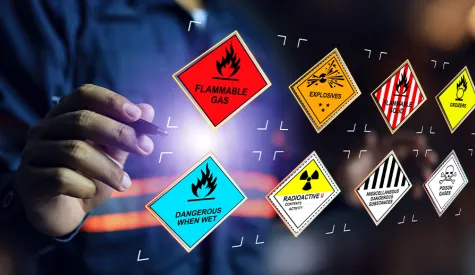HCS Pictograms and Hazards

New Labeling Requirements of the Globally Harmonized System (GHS)
Consistency in the labeling of chemicals is critical to the new Globally Harmonized System standards.
How to Use GHS Icons
There are nine pictograms or icons used with the Globally Harmonized System (GHS) to convey health, physical, and environmental hazards. The final Hazard Communication Standard (HCS) requires use of eight of these icons, but there is an exception for the environmental pictogram, as environmental hazards are not within the jurisdiction of the Occupational Safety & Health Administration (OSHA). Use of the environmental icon is discretionary—it’s up to you. The hazard icons and corresponding hazards are each shown below.
“Pictogram” means a graphic composition that may include a symbol, plus other elements, such as a border, background pattern, or color that conveys specific information. They are icons, signs, or symbols, with meaning that make recognition easier on sight. With the GHS, all hazard pictograms should be in the shape of a square set on a point (diamond).
Pictograms must have red borders. OSHA believes that the use of the red frame will increase recognition and comprehensibility, as the color red naturally attracts the eye above all other colors, and naturally suggest danger, or caution. That’s why the red frame is required regardless of whether the shipment is domestic or international. A black border may be used in some circumstances if restricted to a specific workplace.
For transport, the icons approved by the UN Model Regulations on the Transport of Dangerous Goods should be used. Transport pictograms must have minimum dimensions of 3.9 inches by 3.9 inches, with exceptions for smaller icons on very small packaging and gas cylinders. Transport pictograms must have symbol on upper half of label, and the pictograms should be affixed to a background of contrasting color.
Labeling Requirements
Chemical manufacturers, importers, distributors, or employers who become newly aware of any significant information regarding the hazards of a chemical, need to revise chemical that specific label within six months of becoming aware of the new information, and must make sure that labels on containers of hazardous chemicals shipped after that time have the new information. Highly important: if the chemical is not currently produced or imported, the chemical manufacturer, importer, distributor, or employer must add the information to the label before the chemical is shipped or introduced into the workplace again.
All parties must be in agreement with the final rule by June 1, 2015, with the exception of distributors, who will be given until December 1, 2015 to ensure all containers in their supply chain are labeled in accordance with the Hazard Communication Standard.
All hazardous chemicals shipped after June 1, 2015, must be labeled with specified elements including pictograms, signal words, and hazard and precautionary statements. Manufacturers, importers and distributors have the option of using the new labeling system before June 1, 2015—that’s probably a good idea, to work out any issues in advance and make a smooth operational transition when the June 1st, 2015, date arrives.
All labels will be required to have:
Standardized Pictograms – use of all 8 mandated by OSHA under the GHS.
Signal Word – either warning or danger to indicate the relative level of hazard severity. “Danger” is more severe than “warning”.
Hazard Statements – these specific categories describe the nature and degree of the hazard(s) of a chemical.
Precautionary Statements – four descriptive phrases of suggested ways to prevent negative effects due to mishandling of hazardous chemicals:
- Prevention
- Response
- Storage
- Disposal
Product Identifier – such as the chemical name, code number or batch number. It should be listed on the label and in Section 1 of the Safety Data Sheet, under identification.
Supplier Identification – name, address and phone number of the chemical manufacturer, distributor or importer, and Hazard icons, signal words and hazard statements are required to be located together on the label


